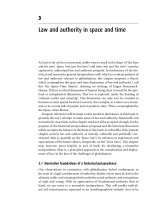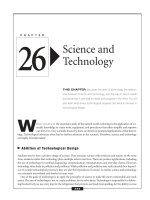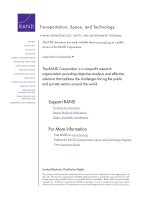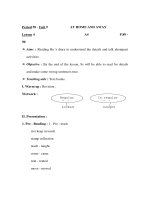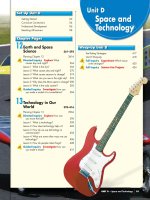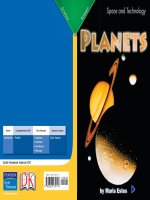4 17 eclipse (space and technology)
Bạn đang xem bản rút gọn của tài liệu. Xem và tải ngay bản đầy đủ của tài liệu tại đây (3.04 MB, 10 trang )
Genre
Nonfiction
Comprehension Skill
Cause and Effect
Text Features
•
•
•
•
Captions
Diagrams
Call Outs
Glossary
Science Content
Earth Cycles
Scott Foresman Science 4.17
ISBN 0-328-13909-2
ì<(sk$m)=bdjajf< +^-Ä-U-Ä-U
Vocabulary
Extended Vocabulary
axis
constellation
eclipse
ellipse
lunar eclipse
orbit
revolution
rotation
solar eclipse
annular eclipse
corona
diamond ring effect
partial eclipse
penumbral shadow
total eclipse
umbral shadow
zone of totality
Picture Credits
Every effort has been made to secure permission and provide appropriate credit for photographic material.
The publisher deeply regrets any omission and pledges to correct errors called to its attention in subsequent editions.
Photo locators denoted as follows: Top (T), Center (C), Bottom (B), Left (L), Right (R), Background (Bkgd).
Opener: Getty Images; 1 Getty Images; 4 Reuters/Corbis; 7 Getty Images; 8 William H. Mullins/Photo Researchers, Inc.;
9 (TR) Frank Zullo/Photo Researchers, Inc.; 10 (T) Reinhard Krause/Reuters/Corbis; 11 (BR) Roger Ressmeyer/Corbis;
13 Reuters/Corbis; 15 Getty Images.
Scott Foresman/Dorling Kindersley would also like to thank: 6 (TC) NASA/DK Images.
Unless otherwise acknowledged, all photographs are the copyright © of Dorling Kindersley, a division of Pearson.
ISBN: 0-328-13909-2
Copyright © Pearson Education, Inc. All Rights Reserved. Printed in the United States of America.
This publication is protected by Copyright, and permission should be obtained from the publisher prior to any
prohibited reproduction, storage in a retrieval system, or transmission in any form by any means, electronic,
mechanical, photocopying, recording, or likewise. For information regarding permission(s), write to
Permissions Department, Scott Foresman, 1900 East Lake Avenue, Glenview, Illinois 60025.
3 4 5 6 7 8 9 10 V010 13 12 11 10 09 08 07 06 05
What did you learn?
1. Compare total and partial solar eclipses.
How are they different?
2. Describe the diamond ring effect. When
and why does this occur?
by Kelly Kong
3. Total solar eclipses and lunar eclipses do
not occur every month. Why not?
4.
There are many good
and bad ways to view solar and lunar
eclipses. Explain some ways in which you
would and would not observe eclipses.
Use examples from the book to support
your answer.
5.
Cause and Effect Occasionally, the
Moon looks red during a lunar eclipse.
Describe what causes this glowing effect.
What You Already Know
Earth spins around an imaginary line called an axis.
The spinning motion is called rotation. As Earth rotates,
it also moves around the Sun. The movement of one
object, such as Earth, around another object, such as the
Sun, is called a revolution. Earth moves around the Sun
in a path called an orbit. Earth’s orbit is an ellipse, or an
oval shape.
Earth’s axis is always tilted in the same direction.
This tilt causes the different seasons. At different points
in the orbital path, some parts of Earth are closer to the
Sun than others. The half of Earth that is tilted toward
the Sun receives more light and heat. The daylight in
this half of Earth lasts longer.
The Sun is the star closest to Earth. Trillions of
other stars occupy the sky. Stars often appear in many
shapes and patterns in the sky. These patterns are called
constellations. People in different regions do not see the
same star patterns. As Earth moves, the stars appear to
move across the sky.
Just as Earth revolves around the Sun, the Moon
moves around Earth. The Moon rotates on its own axis
as it revolves around Earth. It does not produce light.
We see the sunlight that reflects off the Moon’s surface.
2
new
Moon
crescent
Moon
first quarter
Moon
third quarter
Moon
full
Moon
phases of the Moon
Sometimes the entire lighted side of the Moon
directly faces Earth. Other times, only a small part of
the lighted section is visible from Earth. The shape of
the Moon appears to change depending on how much
of the lighted part can be seen from Earth. The different
shapes that we see are called the phases of the Moon.
An eclipse occurs when an object moves between
the Sun and another object and casts a shadow on the
second object. A lunar eclipse takes place when Earth is
between the Sun and the Moon. The Moon is covered
by Earth’s shadow. A solar eclipse occurs when the
Moon is between the Sun and Earth. The Moon blocks
our view of the Sun.
The movement of the Sun, the Moon, and Earth
greatly affect each other. To learn more about eclipses,
as well as the Sun, the Moon, and Earth, keep reading!
3
The Power of the Sun
The closest star to Earth is the Sun. It provides energy
and light to all of Earth’s living things. The Sun plays an
important role in all life cycles.
The Sun, however, can also be harmful. It is so powerful
that if you look at it directly, it can cause permanent
damage to your eyes. It can even blind you. It is important
never to look directly at the Sun without protective
eyewear, even when the Sun is covered by an eclipse.
Eclipses do not occur only with Earth and the Moon.
They can occur with other planets in the solar system.
One of Jupiter’s moons can move into Jupiter’s shadow,
causing a lunar eclipse. But we are most familiar with
eclipses that take place between Earth and the Moon.
These students are using protective eyewear
to watch a solar eclipse.
As the Moon travels in its orbit, it can move
between Earth and the Sun. This keeps sunlight from
reaching Earth. The Moon’s shadow is cast on Earth.
This is a solar eclipse.
How a Solar Eclipse Occurs
partial shadow
area covered by
total eclipse
Earth
sunlight
Moon
total shadow
area covered by
partial eclipse
As the Moon continues its orbit, Earth may move
between the Sun and the Moon. Earth is in the path of
sunlight to the Moon. This prevents the Sun’s light
from reaching the Moon. This is a lunar eclipse.
How a Lunar Eclipse Occurs
total shadow
Moon
sunlight
Earth
4
partial shadow
5
Corona
If you watched a solar eclipse
from beginning to end, this is
what you would see.
Solar Eclipse
There are three different kinds of solar eclipses:
total eclipses, partial eclipses, and annular eclipses. A
total eclipse is the rarest kind of eclipse.
In a total solar eclipse, the Moon completely blocks
the light of the Sun. The eclipse begins as the Moon
slowly makes its way between the Sun and Earth. It
appears to cover more and more of the Sun. A total
solar eclipse occurs when the Moon is between the Sun
and Earth. The Sun is completely blocked by the Moon.
The Sun’s corona becomes more visible than it usually
is to those on Earth. The corona is a glowing halo of
light that surrounds the Sun. You can see the corona in
the center of the image above.
6
Just before the eclipse reaches its peak, a diamond
ring effect may form for a few seconds. This effect is
caused by the Sun’s light shining through very short
valleys, or craters, on the uneven surface of the Moon.
A bead of light that sparkles and looks like a diamond
may be visible from Earth. The bead of light, combined
with the Sun’s corona, makes a diamond ring effect
during the eclipse.
A solar eclipse cannot be seen from everywhere
on Earth. The area from which a solar eclipse can be
seen is called the zone of totality. This zone is ten
thousand miles long but only one hundred miles wide.
An eclipse is usually not visible at any one point for
more than eight minutes.
The small bead of
light shining past
the Moon’s surface
shows the diamond
ring effect.
7
Partial Eclipse
Annular Eclipse
Another kind of solar eclipse is called a partial
eclipse. Partial eclipses are much more common than
total eclipses. A partial solar eclipse happens when part
of the Moon’s shadow passes over part of Earth’s
surface. The center of the Moon does not pass directly
over the center of the Sun. The Moon appears to cover
only part of the Sun.
Partial eclipses are more dangerous to the human
eye than total eclipses. During a partial eclipse, a large
portion of the Sun can still be seen. The brightness of
the Sun can harm the eyes of anyone who looks at it.
Just like a total eclipse, an
annular eclipse occurs when
the Moon is directly between
Earth and the Sun. But the
Moon must also be farthest
from Earth in its orbit. The
great distance between the
Moon and Earth means the
Moon can’t block all of the
Sun. Some of the darkest parts
of the Moon’s shadows will
not reach Earth. Because of
this, a bright ring of Sun
remains, as shown photo.
During a partial solar eclipse, the Moon
covers only some of the Sun.
During an annular eclipse,
many places only see a
partial eclipse.
How an Annular Eclipse Occurs
area that Moon’s
shadow can’t reach
area covered
by annular
eclipse
Earth
sunlight
Moon
8
area covered by
partial eclipse
9
This is the sequence the Moon
follows during a lunar eclipse.
Lunar Eclipse
In addition to being elliptical, the Moon’s orbit is
also tilted. This tilt usually keeps the Moon out of
Earth’s shadow. But sometimes the Moon crosses
Earth’s shadow. A lunar eclipse occurs when a full
Moon passes through Earth’s shadow.
Earth’s shadow is made of two parts. The first part
is the outer, or penumbral, shadow. In this part of the
shadow, Earth blocks part of the Sun’s light from
reaching the Moon. Penumbral shadows are faint
partial shadows. They cause penumbral lunar eclipses,
which are difficult to see.
The second part, which is located in the middle of
the penumbral shadow, is the inner, or umbral, shadow.
This full shadow blocks all sunlight from reaching
the Moon.
10
When only part of the Moon crosses the umbral
shadow, a partial lunar eclipse takes place. If the whole
Moon crosses Earth’s umbral shadow, a total lunar
eclipse takes place. A total eclipse may last more than
an hour.
When the Moon is in Earth’s umbral shadow, some
sunlight still manages to reach it. This sunlight, however,
first passes through the Earth’s atmosphere, which filters
out some colors in the light. The light that reaches the
Moon can be deep red or orange. This can give the
Moon a red glow.
A lunar eclipse that is
taking place can be seen
wherever it is night on
Earth. It can take up to
four hours for Earth’s
shadow to completely
cross the face of
the Moon.
The Moon may look
red during an eclipse.
11
Watching Eclipses
DANGER!
You need proper
equipment to
watch an eclipse
safely. You can
use filters that
have aluminum,
chromium, or
silver to view
an eclipse.
Even though you may
want to stare directly at the
Sun during eclipses, it is
important to protect your
eyes. Lunar eclipses are easier
to observe than solar eclipses.
The Sun is incredibly bright
and powerful. As a result,
solar eclipses are harmful to
your eyes. Solar eclipses are
best viewed indirectly.
You can watch an eclipse by projecting the
Sun through binoculars onto a sheet of
paper or a board.
sunlight
12
Sun’s
image
An example of an indirect method to observe solar
eclipses is using the pinhole camera method. With this
method, the Sun’s image is projected onto a light-colored
board or sheet of paper.
First, take a sheet of paper and prop it up or place it
on the ground. Then, use another sheet of paper and
poke a small hole in it. Attach this paper to a pair of
binoculars. Stand with the Sun behind you and look at
the first sheet of paper. The image of the eclipse will be
visible on the paper.
Other instruments can also be used to view solar
eclipses. Special binoculars, eyeglasses, and goggles are
often used. Ordinary sunglasses, however, are not strong
enough to protect your eyes when looking directly at
the Sun.
Look directly at an
eclipse only with
special eclipse glasses.
13
Predicting Eclipses
total solar
eclipse
If the Moon’s orbit were not tilted, solar and lunar
eclipses could happen each month. A solar eclipse would
occur every time the Moon was new, and a lunar eclipse
would take place every time the Moon was full. However,
due to the Moon’s tilt, eclipses take place only when the
Sun, the Moon, and Earth are perfectly in line with each
other. This does not happen very often.
total solar eclipses to 2020
2008
ugust
20
15
1A
h
arc
20 M
20
06
ugust 2017
21 A
8
M
29
A
l 2005
p ri
2 Ju
ly
20
14
Ju
ly
2
0
19
vember 2012
11
13
No
2
ber
3 Novem
14 Dec
01
2
er
emb
02
0
13
20
09
ar
c
h
22 July
h
9 Marc
1
20
6
Predicting eclipses
is relatively easy due to
the regular orbits of the Sun,
the Moon, and Earth. The map
to the left predicts total eclipses
through 2020.
A total solar eclipse occurs about every one and a
half years somewhere in the world. However, these
eclipses often fall over the ocean or in areas where only
a few people live. Lunar eclipses occur more frequently.
They may happen several times a year.
We know a great deal about the Sun, the Moon,
Earth, and their orbits. This information helps scientists
predict eclipses far into the future. The time and place
of past eclipses are also easy to calculate. Some people
go on special trips just to watch eclipses happen. Where
would you go if you took a trip to see an eclipse?
0
15
Vocabulary
Glossary
axis
constellation
annular
eclipse eclipse
ellipse
lunar eclipse
orbit
revolution
corona
rotation
solar eclipse
Extended Vocabulary
annular eclipse
corona
an eclipse
that occurs
when the
diamond
ring effect
Moon
is at the
farthest point from
partial
eclipse
Earthpenumbral
in its orbit shadow
and is directly
between
Sun and Earth
totalthe
eclipse
umbral shadow
the Sun’s outer atmosphere that
zone of totality
looks like a halo of light around
the Sun
diamond ring effect
a bead of light resembling a
diamond, which shines through
a valley of the Moon during
an eclipse
partial eclipse
an eclipse that occurs when part
of the Moon’s shadow passes over
part of Earth’s surface
Picture Credits
Every effort has been made to secure permission and provide appropriate credit for photographic material.
The publisher deeply regrets any omission and pledges to correct errors called to its attention in subsequent editions.
penumbral shadow
faint, outer shadow
Photo locators denoted as follows: Top (T), Center (C), Bottom (B), Left (L), Right (R), Background (Bkgd).
total eclipse
an eclipse that occurs when the
Moon completely blocks the light
the6 (TC)
Sun
from
reaching Earth
Scott Foresman/Dorling Kindersley would also likeof
to thank:
NASA/DK
Images.
Opener: Getty Images; 1 Getty Images; 4 Reuters/Corbis; 7 Getty Images; 8 William H. Mullins/Photo Researchers, Inc.;
9 (TR) Frank Zullo/Photo Researchers, Inc.; 10 (T) Reinhard Krause/Reuters/Corbis; 11 (BR) Roger Ressmeyer/Corbis;
13 Reuters/Corbis; 15 Getty Images.
Unless otherwise acknowledged, all photographs are the copyright © of Dorling Kindersley, a division of Pearson.
umbral shadow
dark, inner shadow
zone of totality
the areas on Earth from where
a total solar eclipse can be seen
ISBN: 0-328-13909-2
Copyright © Pearson Education, Inc. All Rights Reserved. Printed in the United States of America.
This publication is protected by Copyright, and permission should be obtained from the publisher prior to any
prohibited reproduction, storage in a retrieval system, or transmission in any form by any means, electronic,
mechanical, photocopying, recording, or likewise. For information regarding permission(s), write to
Permissions Department, Scott Foresman, 1900 East Lake Avenue, Glenview, Illinois 60025.
3 4 5 6 7 8 9 10 V010 13 12 11 10 09 08 07 06 05
16
What did you learn?
1. Compare total and partial solar eclipses.
How are they different?
2. Describe the diamond ring effect. When
and why does this occur?
3. Total solar eclipses and lunar eclipses do
not occur every month. Why not?
4.
There are many good
and bad ways to view solar and lunar
eclipses. Explain some ways in which you
would and would not observe eclipses.
Use examples from the book to support
your answer.
5.
Cause and Effect Occasionally, the
Moon looks red during a lunar eclipse.
Describe what causes this glowing effect.
